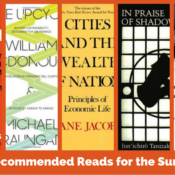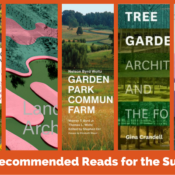Author: Lisa Horne
5 More Recommended Reads for the Summer
School is starting again. In the next few weeks, the hum of professional networking events will return and clients and fellow consultants will be back in town. But there is still a little time left to fit in one or two more summer reads. Following up from my previous article “Five Recommended Reads for the Summer,” below are five more recommended books to keep creativity sharp.
 Art’s Principles: 50 years of hard-learned lessons in building a world-class professional services firm by Arthur Gensler and Michael Lindemayer
Art’s Principles: 50 years of hard-learned lessons in building a world-class professional services firm by Arthur Gensler and Michael Lindemayer
The 62 lessons are each several pages and accompanied with playful hand sketches to illustrate concepts in a total of 318 pages. Any lesson stands alone, but the book is also a nice read cover to cover. The distilled wisdom is readable, but profound in a way that makes it worth reading twice. It fits easily in a briefcase or purse and is a perfect read for the lines at the airport. You just may want to have a pen handy to underline.
 The Upcycle: Beyond Sustainability – Design for Abundance by William McDonough and Michael Braungart
The Upcycle: Beyond Sustainability – Design for Abundance by William McDonough and Michael Braungart
As a follow up to Cradle to Cradle written over a decade earlier, this book discusses changes during the intervening years and looks at what the future may hold. McDonough has an unmatched optimism that is a marked contrast to the prevailing cynicism. As sustainability becomes more mainstream to the profession and as we adjust to another version of LEED, it is worth revisiting sustainability’s purpose and the value it adds. In 227 pages, this book is like a ray of sunshine to have on hand for a rainy weekend.
 Cities and the Wealth of Nations by Jane Jacobs
Cities and the Wealth of Nations by Jane Jacobs
With the audacity to call macro-economics in the 1980s, when this book was written, “in shambles,” Jacobs delivers a still provocative and easily accessible read on economics as it relates to city and region. The ideas are strangely prescient of today’s issues and are a great introduction to Jane Jacobs if you have avoided reading The Death and Life of Great American Cities, a longer and denser classic. At 272 pages, Cities and the Wealth of Nations is a small book that could fit in your pocket and be read anywhere.
 In Praise of Shadows by Junichiro Tanizaki
In Praise of Shadows by Junichiro Tanizaki
More of an essay than a book, this short work of 56 pages by a Japanese novelist explores his culture’s aesthetic approach to creating a sense of space. In terms of causing a paradigm shift in the fewest number of pages, there is probably no equal for a creative jolt. A great book to read in a spare hour.
 Feral: Rewilding the Land, the Sea, and Human Life by George Monbiot
Feral: Rewilding the Land, the Sea, and Human Life by George Monbiot
Generational amnesia is the tendency for each generation to assume what is present day is the normal baseline and is what has always been. With journalistic flare, Monbiot exposes how many of our assumptions of what is the natural world are, in fact, faulty. He passionately argues for bringing back wild animals such as the beaver that have been lost to certain regions and explores scenarios to make that happen. Monbiot’s enthusiasm for the wild is a good reminder of why many of us choose the profession of landscape architecture in the first place. At 344 pages, content and delivery make for an absorbing read. This book is a good one for a cross-country flight.
Read one or more. Each one adds a different perspective to our practice with inspiration, insight, or humor. Do you think that there should be another book on this list? Please provide a comment below to share.
—
Lisa Horne, PLA, LEED AP BD+C is a landscape architect and Project Director at RVi Planning + Landscape Architecture in Dallas. See her current reading list at Goodreads.
Five Recommended Reads for the Summer
It’s summer and that can mean a slowing down of creative interchanges in the classroom or at local professional events. Sometimes Dallas and other cities across the US seem to be in a kind of lull with the summer heat and the lessened activity compared to spring and fall.
A stack of lighter books on hand will help keep that creative spark alive into the fall. While these are not novels for summer beach reading, the following five books will keep your designer mind sharp and your curiosity intrigued. In August, another set of five recommendations will finish out the summer.
 The Inspired Landscape: Twenty-One Leading Landscape Architects Explore the Creative Process by Susan Cohen
The Inspired Landscape: Twenty-One Leading Landscape Architects Explore the Creative Process by Susan Cohen
This book comprises case studies of creative inspiration behind a project for twenty-one renowned landscape architects in the United States and abroad. With photographs and sketches in 268 pages, it gives an overview of the current state of design in the profession and is a good reminder that inspiration comes from many places. Keep this by your office desk and leaf through for a design boost.
30:30 Landscape Architecture by Meaghan Kombol
Recognizing the value of mentorship in the profession, Kombol interviewed thirty pairs of designers, one established and one emerging that the former had recommended. The result is a 320 page transect of the current state of the profession accompanied with curated photographs and renderings of projects. Each interview is one page of text with three to five pages of images and can be read as a standalone piece. The surprise in the book is the similarity in the conversations about the state of the profession from practitioners across the globe.
Nelson Byrd Woltz: Garden, Park, Community, Farm by Warren Byrd, Thomas Woltz, and Elizabeth Meyer
As the only monograph on the list, this book is a feast of lucid plans and photography. The diversity of projects covered in 208 pages is satisfying. Water is a frequent theme. This is a book to keep in the office as a source of inspiration of what landscape architecture can be.
Tree Gardens: Architecture and the Forest by Gina Crandell
Tree Gardens provides fifteen case studies from 1544 to 2004 on different applications of trees in design. Each case study is about ten pages and illustrated with photographs or historical illustrations. Total length is 165 pages. Case studies include the new or relatively unknown along with fresh details of the familiar such as Central Park and Versailles. The technical information is specific and plentiful. The approach on tighter tree spacing may not be for everyone, but is well researched and argued in the text. It is a read that challenges some of the conventional wisdom of landscape architecture and is probably best accompanied with a café au lait early on a weekend morning.
The Architecture of Happiness by Alain De Bottom
As the most philosophical piece on the list, The Architecture of Happiness explores the designed environment from Brasilia to Villa Savoye to glassware and raises fascinating questions about design for thoughtful examination. In the same general category of environmental awareness or phenomenology as Gaston Bachelard’s The Poetics of Space, this one has much of the latter’s intellectual vigor and wit while maintaining accessibility to the text. Through the 288 pages of this book, the arguments subtly build so that it is best read in just a few sittings. This book is recommended reading on a quiet evening with a good bottle of wine.
Read one or read all five. Each one is an interesting conversation in and of itself and adds value or inspiration to what we do as practitioners. Is there a book that was missed? Please provide a comment below to share.
—
Lisa Horne, PLA, LEED AP BD+C is a landscape architect and Project Director at RVi Planning + Landscape Architecture in Dallas. See her current reading list at Goodreads.










